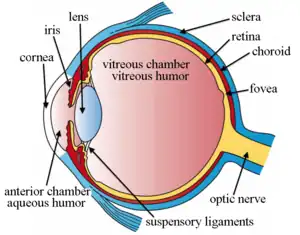Intracameral injection
| Intracameral injection | |
|---|---|
 Intravitreal administration delivers substances directly into the anterior chamber of eyeball. | |
| Specialty | ophthalmology |
An intracameral injection is usually of an antibiotic into the anterior chamber of the eyeball to prevent endophthalmitis caused by an infection of the eye that can occur after cataract surgery. The Food and Drug Administration (FDA) has not approved antibiotics for this use and it is considered 'off-label'. Concerns about this procedure contributing to increasing numbers of antibiotic resistant bacteria have been expressed.[1]
In the UK, Aprokam cefuroxime has been approved for use in intracameral injections.[2] Intracameral injection of recombinant tissue plasminogen activator (r-TPA) has been found to be effective in treating the development of fibrin intraocularly after the development of endophthalmitis.[3]
References
- ↑ Editor, Christopher Kent, Senior. "Antibiotics & Cataract Surgery: New Frontiers". Retrieved 3 April 2017.
{{cite web}}:|last=has generic name (help) - ↑ "Aprokam cefuroxime 50mg powder for solution for injection - Summary of Product Characteristics (SPC) - (eMC)". Retrieved 3 April 2017.
- ↑ Wu, T-T; Wang, H-H (2007). "Intracameral recombinant tissue plasminogen activator for the treatment of severe fibrin reaction in endophthalmitis". Eye. 23 (1): 101–107. doi:10.1038/sj.eye.6702984. ISSN 0950-222X. PMID 17901882.
This article is issued from Offline. The text is licensed under Creative Commons - Attribution - Sharealike. Additional terms may apply for the media files.